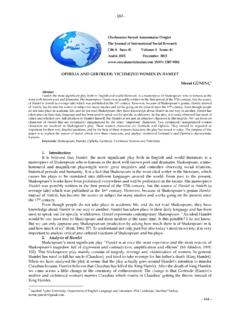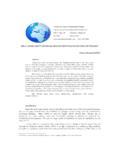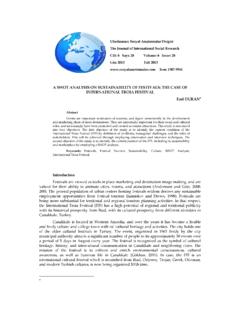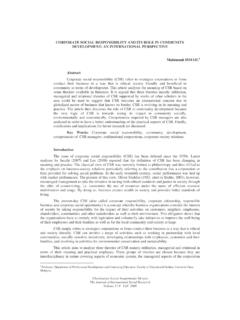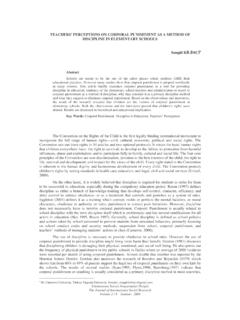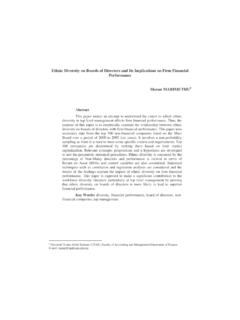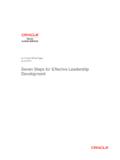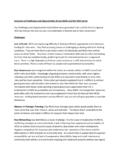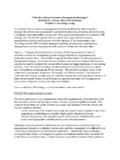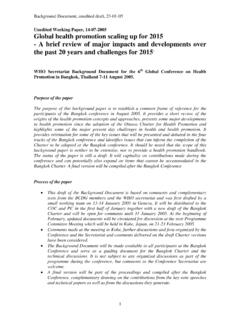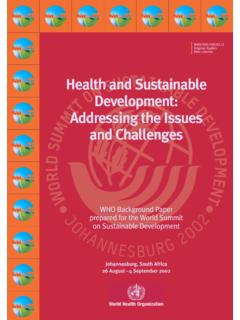Transcription of MAJOR CHALLENGES TO THE EFFECTIVE …
1 MAJOR CHALLENGES TO THE EFFECTIVE MANAGEMENT OF HUMAN RESOURCE. TRAINING AND DEVELOPMENT ACTIVITIES. Haslinda ABDULLAH . Abstract Human resource training and development (HR T&D) in manufacturing firms is a critical aspect of the development of a knowledge-workforce in Malaysia. The objective of this study is to examine CHALLENGES to the EFFECTIVE management of HR T&D activities in manufacturing firms in Malaysia. In order to achieve this objective, in-depth interviews were conducted with 58 HR managers managing employees' training and development, employing a purposive or judgmental sampling technique. The study revealed three MAJOR CHALLENGES to the EFFECTIVE management of HR T&D. These include a shortage of intellectual HRD professionals to manage HR T&D activities, coping with the demand for knowledge workers and fostering learning and development in the workplace.
2 It is hoped that the findings of this study will provide HR professionals with a clear understanding and awareness of the various CHALLENGES in managing EFFECTIVE HR training and development. Hence, relevant and appropriate policies and procedures can be developed and implemented for an EFFECTIVE management of HR T&D. Key Words: human resource tarining, MAJOR CHALLENGES INTRODUCTION. In the midst of transforming itself into a knowledge-based economy (k-economy), Malaysia, being a developing country, believes that building a knowledge-based workforce is imperative, particularly in the manufacturing sector. This is because manufacturing accounts for one third of the GDP and more than 70. percent of the country's exports, and contributes significantly towards its economic growth.
3 Out of the total population of million, 12 million are in the labour force and million are employed in the manufacturing sector (Malaysia, Ministry of Finance, 2008). As a result, training and development (T&D) of human resources in the manufacturing sector is vital in preparing a capable and skilled workforce with the expertise to meet current and future CHALLENGES by providing them with technological skills as well as critical thinking abilities. In supporting human resources' T&D, the Government has introduced and implemented the Human Resource Development Act (1992), and a range of support mechanisms, incentives and initiatives to assist the manufacturing sector. This is because the Government believes that investment in human capital is the key to the success of the country's economic growth.
4 However, despite the support, incentives and initiatives implemented for HR T&D, the fact remains that problems or CHALLENGES to the EFFECTIVE management of HR. T&D can arise. Empirical evidence from other developed and developing countries has identified considerable CHALLENGES to the management of HR T&D (see for example, Al Bahar, et al. 1996; Ardichvili and Gasparishvili, 2001; Lloyd, 2002; Budhwar and Sparrow, 2002; Budhwar, Al-Yamadi & Debrah, 2002;. Alzalabani, 2002; Bing, et al, 2003). However, there is limited empirical evidence of CHALLENGES in managing HR T&D in Malaysia. Therefore, the objective of this study is to examine CHALLENGES to the EFFECTIVE management of HR T&D activities, particularly in manufacturing firms. It is hoped that the findings of this study will give HR professionals a clear understanding of the various CHALLENGES to the EFFECTIVE management.
5 Assoc. Prof. Dr., Faculty of Economics & Management, Universiti Putra Malaysia Uluslararas Sosyal Ara t rmalar Dergisi The Journal of International Social Research Volume 2 / 8 Summer 2009. 12 Haslinda ABDULLAH. of HR T&D. Hence, relevant and appropriate policies and procedures can be developed and implemented for the EFFECTIVE management of human resources' T&D. LITERATURE REVIEW. A range of CHALLENGES are faced by organisations and HRD professionals in managing and implementing EFFECTIVE HR T&D, particularly in the climate of globalisation, and the new technological revolution begins with the importance of human capital in HRD practice, their education and technical training, and also their communication and language skills. Human resources' learning and motivation are also described as important features of EFFECTIVE HRD practices.
6 However, their deficiencies in supporting the effectiveness of HR T&D pose a challenge to the development, management and implementation of EFFECTIVE HR T&D in organisations. Furthermore, the workforce's changing demographics are also seen to have an impact on HRD practices, alongside the organisation's HR strategies and investments in HR T&D. Human Capital in HRD Practice The central factor in HRD is the human resources or the human capital in an organisation. They are viewed as the driving force for the success of organisations because of their skills, competencies, knowledge and experience (Becker, 1975; Schmidt & Lines, 2002; Harrison & Kessels, 2004). Moreover, it has been suggested that for organisations to compete successfully in a global economy, it is important to hire sufficiently educated and skilled employees and provide them with lifelong learning (Nadler & Wiggs, 1986.)
7 Chalofsky & Reinhart, 1988; Nadler & Nadler, 1989; O'Connell, 1999; Streumer et al, 1999; Low, 1998;. Harrison, 2000; Sadler-Smith et al, 2000). However, these are some of the problems faced by employers and organisations and seen as a hindrance to the EFFECTIVE management, training and development of human resources in a global economy (Roberts & McDonald, 1995; Fernald et al, 1999; Shim, 2001; Lloyd, 2002;. Budhwar et al, 2002; Bates et al, 2002). In the specific context of HRD professionals, the literature has indicated that there is a shortage of HRD professionals who are skilled and experienced systems thinkers (Bing et al, 2003), and who have the ability to manage the vast and specialised function of HRD across organisations (Eidgahy, 1995; Buyens et al, 2001; Garavan, et al, 2002).
8 For instance, it was reported by Budhwar et al (2002) that the lack of HRD professionals in Oman is a MAJOR obstacle to the nation's HRD. efforts. Kerr & McDougall (1999) argued that problems also arise due to a lack of experience and understanding of HR T&D on the part of managers. Indeed, some writers have claimed that HRD. professionals do have an important role, as they possess expertise in learning and in developing others to become experts (Wright et al, 1999; Eichinger & Ulrich, 1998; Chermack et al, 2003). Education and Technical Training The fundamental issues regarding human resources' lack of capabilities and intellectual abilities are said to be grounded in their levels of education and technical training (Low, 1998). It has been reported that organisations are faced with a challenge in acquiring high calibre human resources with adequate levels of education (O'Connell, 1999; Streumer et al, 1999).
9 For instance, Silver (1991) reported that studies have shown that employees in British firms are seen to have low levels of educational and training qualifications compared to their competitor nations. Following this lead, if Britain, a developed country, is seen to have this problem, it is likely to be even more evident in developing countries. On this note, the International Labour Organisation has reported that more than half of the workforce in manufacturing firms, particularly in the South East Asia Region, only possess educational qualifications at primary level or lower (ILO, 1997). The arguments arise that as well as possessing the required skills for the job and being knowledgeable and trainable, human resources should also be required to posses at least a college or university qualification (Low, 1998; Chermack et al, 2003).
10 However, the generalisation of this standard of education to all levels of employees is unclear and requires further empirical evidence. Nevertheless, it is agreed that an undergraduate degree provides the essential intellectual human capital' on which to build future learning and also a knowledge-workforce (ILO, 1997; Harrison & Kessels, 2004). Uluslararas Sosyal Ara t rmalar Dergisi The Journal of International Social Research Volume 2 / 8 Summer 2009. MAJOR CHALLENGES to the EFFECTIVE Management of Human Resource Training and Development Activities 13. At the other extreme, some theorists have posited that human resources' level of education is interrelated with communication and language (see for example, Desimone et al, 2002; Alzalabani, 2002.)
